Related Research Articles

Gelatin or gelatine is a translucent, colorless, flavorless food ingredient, commonly derived from collagen taken from animal body parts. It is brittle when dry and rubbery when moist. It may also be referred to as hydrolyzed collagen, collagen hydrolysate, gelatine hydrolysate, hydrolyzed gelatine, and collagen peptides after it has undergone hydrolysis. It is commonly used as a gelling agent in food, beverages, medications, drug or vitamin capsules, photographic films, papers, and cosmetics.

Molasses is a viscous byproduct, principally obtained from the refining of sugarcane or sugar beet juice into sugar. Molasses varies in the amount of sugar, the method of extraction and age of the plant. Sugarcane molasses is usually used to sweeten and flavour foods. Molasses is a major constituent of fine commercial brown sugar.
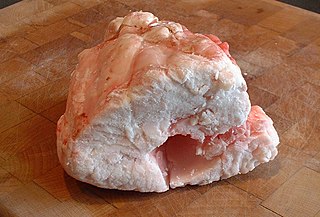
Suet is the raw, hard fat of beef, lamb or mutton found around the loins and kidneys.
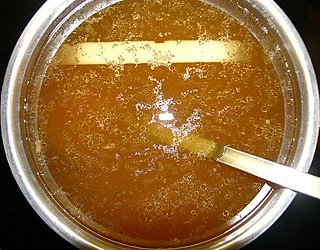
Broth, also known as bouillon, is a savory liquid made of water in which meat, fish, or vegetables have been simmered for a short period of time. It can be eaten alone, but it is most commonly used to prepare other dishes, such as soups, gravies, and sauces.

Stock, sometimes called bone broth, is a savory cooking liquid that forms the basis of many dishes – particularly soups, stews, and sauces. Making stock involves simmering animal bones, meat, seafood, or vegetables in water or wine, often for an extended period. Mirepoix or other aromatics may be added for more flavor.

Irish stew or Stobhach is a stew native to Ireland that is traditionally made with root vegetables and lamb or mutton, but also commonly with beef. As in all traditional folk dishes, the exact recipe is not consistent from time to time, or place to place. Basic ingredients include lamb, or mutton, as well as potatoes, onions, and parsley. It may sometimes also include carrots. Irish stew is also made with kid. Irish stew is considered a national dish of Ireland.
Irish stew is a celebrated Irish dish, yet its composition is a matter of dispute. Purists maintain that the only acceptable and traditional ingredients are neck mutton chops or kid, potatoes, onions, and water. Others would add such items as carrots, turnips and pearl barley; but the purists maintain that they spoil the true flavour of the dish. The ingredients are boiled and simmered slowly for up to two hours. Salt can be added before or after the cooking. Mutton was the dominant ingredient because the economic importance of sheep lay in their wool and milk produce and this ensured that only old or economically non-viable animals ended up in the cooking pot, where they needed hours of slow cooking. Irish stew is the product of a culinary tradition that relied almost exclusively on cooking over an open fire. It seems that Irish stew was recognised as early as about 1800.
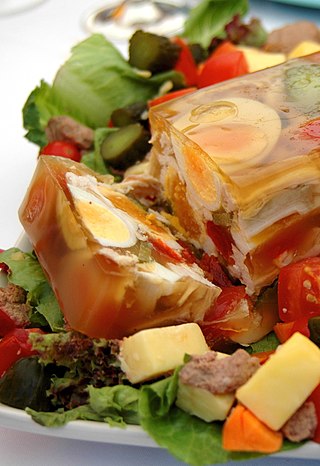
Aspic or meat jelly is a savory gelatin made with a meat stock or broth, set in a mold to encase other ingredients. These often include pieces of meat, seafood, vegetable, or eggs. Aspic is also sometimes referred to as aspic gelée or aspic jelly. In its simplest form, aspic is essentially a gelatinous version of conventional soup.

Korean royal court cuisine was the style of cookery within Korean cuisine traditionally consumed at the court of the Joseon Dynasty, which ruled Korea from 1392 to 1910. There has been a revival of this cookery style in the 21st century. It is said that twelve dishes should be served along with rice and soup, with most dishes served in bangjja (bronzeware).
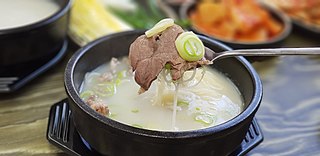
Seolleongtang (설렁탕) or ox bone soup is a Korean broth tang (soup) made from ox bones, brisket and other cuts. Seasoning is generally done at the table according to personal taste by adding salt, ground black pepper, red pepper, minced garlic, or chopped spring onions. It is a local dish of Seoul.

Mì Quảng, literally "Quảng noodles", is a Vietnamese noodle dish that originated from Quảng Nam Province in central Vietnam. In the region, it is one of the most popular and nationally recognized food items, and is served on various occasions such as at family parties, death anniversaries, and Tết.

Soups in East Asian culture are eaten as one of the many main dishes in a meal or in some cases served straight with little adornment, particular attention is paid to the soups' stocks. In the case of some soups, the stock ingredients become part of the soup. They are usually based solely on broths and lacking in dairy products such as milk or cream. If thickened, the thickening usually consists of refined starches from corn or sweet potatoes.
A master stock or master sauce is a stock which is repeatedly reused to poach or braise meats. It has its origins in Chinese cuisine and is typically used in Cantonese and Fujian cuisines. Foods poached or braised in the master stock are generally referred to as lou mei.

Gopchang-jeongol (곱창전골) or beef tripe hot pot is a spicy Korean stew or casserole made by boiling beef tripe, vegetables, and seasonings in beef broth. Gopchang refers to beef small intestines, while jeongol refers to a category of stew or casserole in Korean cuisine. Although the dish is mainly based on beef gopchang, other parts of beef innards are also used to give the dish a richer flavor and chewy texture.
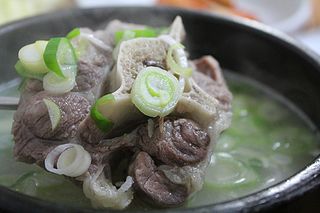
Gomguk (Korean: 곰국), gomtang (곰탕), or beef bone soup refers to a soup in Korean cuisine made with various beef parts such as ribs, oxtail, brisket, ox's head or ox bones by slow simmering on a low flame. The broth tends to have a milky color with a rich and hearty taste.
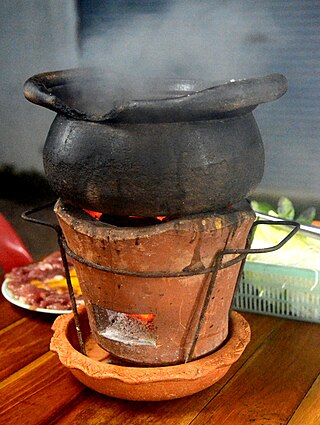
Chim chum is a Southeast Asian street food, popular especially in Thailand. It is traditionally made with chicken or pork and fresh herbs such as galangal, sweet basil, lemongrass and kaffir lime leaves, cooked in a small clay pot on a charcoal stove. It is often served with nam chim.

Hot pot or hotpot, also known as steamboat, is a dish whereby a heat source placed on the dining table keeps a pot of soup stock simmering, and a variety of Chinese foodstuffs and ingredients are served beside the pot for the diners to put into the hot stock.

Hui mian is a Henan-style noodle soup. The ingredients used in the dish vary across different cities and restaurants. Typically, hui mian is made with lamb bones and a range of Chinese herbs, such as lycium chinense and star anise. However, kelp, tofu, coriander, quail eggs, chili oil, sugar, garlic, and minced peppers are also common ingredients.
Animal products in pharmaceuticals play a role as both active and inactive ingredients, the latter including binders, carriers, stabilizers, fillers, and colorants. Animals and their products may also be used in pharmaceutical production without being included in the product itself.

Gelita AG is a manufacturer of gelatin and collagen peptides for the food, health and nutrition, pharmaceutical industries and for several technical applications. It is headquartered in Eberbach, Germany.

Kway jap, also spelt kuay jap is a Teochew noodle soup originating in Chinese cuisine consisting of flat, broad rice sheets (kway) in a soup made with dark soy sauce, served with an assortment of pork cuts including offal, pork belly, intestines, and pig's ears, braised duck meat, various kinds of beancurd, preserved salted vegetables, and braised hard-boiled eggs.
References
- ↑ US4176199A,Vollmer, Arthur N.&Rainey, George E.,"Extraction of protein from edible beef bones and product",issued 1979-11-27
- ↑ "Bone Broth: A-Z". Grand View Farm. Retrieved 2024-05-04.
- ↑ "Health Benefits of Bone Marrow". WebMD. Retrieved 2024-05-04.
- 1 2 "Top 5 health benefits of bone broth". Good Food. Retrieved 2024-05-04.
- ↑ "BEEF BONE COLLAGEN EXTRACT - An ideal Ingredient for functional foods". Taranaki Bio Extracts. 2022-10-02. Retrieved 2024-05-04.
- ↑ "Everything you need to know about BONE BROTH! | Boob to Food". boobtofood.com. Retrieved 2024-05-04.
- ↑ "Bone Broth for health and tasty meals". Natural Nigerian. 2014-03-03. Retrieved 2024-05-04.
- ↑ "The top 6 bone broth benefits". www.medicalnewstoday.com. 2020-01-12. Retrieved 2024-05-04.